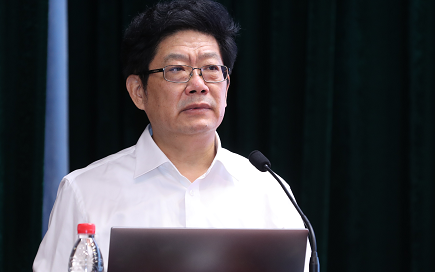As the shocks of the COVID-19 pandemic unfolded over the past year, global food systems faced significant challenges and opportunities. The 2021 China and Global Agricultural Policy Forum, co-organized by IFPRI and the Chinese Academy of Agricultural Sciences (CAAS) on May 25 in Beijing, focused on the future of global food systems and China’s agrifood system in light of these changes. The CAAS’s annual China Agricultural Sector Development Report 2021 (CASDR) and the IFPRI flagship 2021 Global Food Policy Report (GFPR) were released at the forum.
The CASDR 2021 offers a comprehensive proposal on the development direction of China’s agrifood system to address multiple challenges such as resource shortages, food waste, and nutritional imbalances. This is in sync with the idea of five food system transformation goals of efficiency, health, resilience, inclusiveness, sustainability and efficiency raised in the 2021 GFPR.
Dietary transition for combat malnutrition
Even before the pandemic, malnutrition remained a significant global problem, noted IFPRI Director General Johan Swinnen: 3 billion people could not afford a healthy diet. Inappropriate diets also contribute to undernutrition. John McDermott, Director of the IFPRI-led CGIAR Research Program on Agriculture for Nutrition and Health (A4NH), noted that COVID-19 has disproportionately affected marginalized people in low- and middle-income countries (LMICs), driving up poverty and malnutrition. Supply chain disruptions have also taken a toll on dietary quality and diversity, leading to increased nutritional deficiencies. Increases were seen in consumption of staples and reductions in consumption of fresh fruits, vegetables, and animal products during this period.
The pandemic took place as broad trends were changing the malnutrition challenge. CAAS Vice President Xurong Mei noted that China’s agricultural production can meet the energy intake demand of residents, but the demand for foods high in proteins and fats has increased substantially and the problem of structural imbalance in diets is prominent. In 2020, China’s per capita energy consumption was 2,248 kcal/day, meeting the recommended daily intake of 2,200-2,300 kcal/day as set by the government’s Food and Nutrition Development Outline (2014-2020). The per capita intake of protein and fat was 85g/day and 79g/day in 2020, respectively, exceeding the recommended standards; the proportion of energy supplied by fat was 34.7%, surpassing the recommended range by 20% to 30% as well.
“Useful ways of combating all kinds of malnutrition are reducing undernutrition, increasing micronutrients, and preventing obesity as well as overweight.” McDermott said. “People should try to mitigate unhealthy elements in the diets and increase the healthy components in a balanced way.” While the world faces slow progress on reducing undernutrition, he said, we should also be concerned with the rapid increase in patterns of obesity: In the lowest income countries, this tends to appear in richer people; but in LMICs and in some rich countries, poor people have the worst diets and the highest rates of obesity.
Mengshan Chen, National Committee Member of the Chinese People’s Political Consultative Conference (CPPCC), noted that in recent decades, China’s agricultural production has been transformed from a subsistence-based food supply to a type that can satisfy both consumer demand and nutritional needs. The composition of the food supply has also changed, from meeting general and bulk food consumption needs to more individualized and customized food consumption, Chen said, while the emphasis on processed products has changed from quantity and safety to health and quality. In the future, producing, processing, and consuming nutritious food will become important guidelines to build a sustainable food system.
“Lots of our food system recommendations for nutrition come from diets—recognizing that diets depend on what consumers want to eat, what they like to taste and what’s good for them,” McDermott said. Optimizing dietary quality and nutrition requires deepening the structural reforms on the agricultural supply side from both ends— production and consumption, he said. This goal will be an important reference for the Chinese government going forward to formulate food production and consumption policies. Chen also suggested subdividing groups in urban and rural areas to carry out more in-depth research on trends in changes in food supply and demand and nutrition, as well as the development of the food industry.
Creativity and innovations of policy system
Governments have made a number of important policy changes to combat the pandemic, including lockdowns, social protection measures, and support for farmers and others in food value chains.
Xiaohua Chen, Vice Director of the CPPCC Agricultural Committee, suggested it is necessary to strengthen analysis of such policy impacts on agriculture, as many different interventions are driving changes.
The GFPR 2021 shows that there has been much creativity and innovations in food systems around the world over the past year and half as they responded to pandemic stresses. McDermott presented four pillars of policy system resilience: “Political willingness is necessary in respond to COVID-19 and other shocks, but it’s not sufficient. We also need capacity of implementation for a resilient policy system, as well as adaptability, coordination, and citizen trust.” He stressed that the public and private sectors must work together efficiently to improve food system transformation; businesses, from farmers to delivery services, are better able to innovate quickly when governments help to create an enabling environment.
Shenggen Fan, Chair Professor of China Agricultural University and former IFPRI Director General, proposed the innovation of the current global agricultural policy system could focus on issues such as the reform of agricultural subsidy policy—shifting from encouraging the use of pesticides and fertilizers to more sustainable technologies, and improved coordination of health, environment, and finance departments.
The forum—the fourth joint annual launch event—was moderated by , IFPRI Senior Research Fellow Kevin Chen and Longjiang Yuan, Director General of the CAAS Institute of Agricultural Economics and Development. IFPRI and CAAS share a longtime partnership, and the forum was held both on-site and broadcast online this year, reaching an audience of more than 3,000.
Qiyun Huang is a Communications Assistant with IFPRI’s East and Central Asia Office in Beijing.







